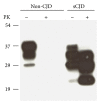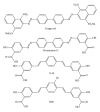Small-molecule theranostic probes: a promising future in neurodegenerative diseases
- PMID: 24324497
- PMCID: PMC3845517
- DOI: 10.1155/2013/150952
Small-molecule theranostic probes: a promising future in neurodegenerative diseases
Abstract
Prion diseases are fatal neurodegenerative illnesses, which include Creutzfeldt-Jakob disease in humans and scrapie, chronic wasting disease, and bovine spongiform encephalopathy in animals. They are caused by unconventional infectious agents consisting primarily of misfolded, aggregated, β -sheet-rich isoforms, denoted prions, of the physiological cellular prion protein (PrP(C)). Many lines of evidence suggest that prions (PrP(Sc)) act both as a template for this conversion and as a neurotoxic agent causing neuronal dysfunction and cell death. As such, PrP(Sc) may be considered as both a neuropathological hallmark of the disease and a therapeutic target. Several diagnostic imaging probes have been developed to monitor cerebral amyloid lesions in patients with neurodegenerative disorders (such as Alzheimer's disease, Parkinson's disease, and prion disease). Examples of these probes are Congo red, thioflavin T, and their derivatives. We synthesized a series of styryl derivatives, denoted theranostics, and studied their therapeutic and/or diagnostic potentials. Here we review the salient traits of these small molecules that are able to detect and modulate aggregated forms of several proteins involved in protein misfolding diseases. We then highlight the importance of further studies for their practical implications in therapy and diagnostics.
Figures









Similar articles
-
From prion diseases to prion-like propagation mechanisms of neurodegenerative diseases.Int J Cell Biol. 2013;2013:975832. doi: 10.1155/2013/975832. Epub 2013 Oct 10. Int J Cell Biol. 2013. PMID: 24222767 Free PMC article. Review.
-
Insights into Mechanisms of Transmission and Pathogenesis from Transgenic Mouse Models of Prion Diseases.Methods Mol Biol. 2017;1658:219-252. doi: 10.1007/978-1-4939-7244-9_16. Methods Mol Biol. 2017. PMID: 28861793 Free PMC article. Review.
-
Prion Protein Devoid of the Octapeptide Repeat Region Delays Bovine Spongiform Encephalopathy Pathogenesis in Mice.J Virol. 2017 Dec 14;92(1):e01368-17. doi: 10.1128/JVI.01368-17. Print 2018 Jan 1. J Virol. 2017. PMID: 29046443 Free PMC article.
-
Animal models for prion-like diseases.Virus Res. 2015 Sep 2;207:5-24. doi: 10.1016/j.virusres.2015.04.014. Epub 2015 Apr 20. Virus Res. 2015. PMID: 25907990 Review.
-
Neuropathology of Animal Prion Diseases.Biomolecules. 2021 Mar 21;11(3):466. doi: 10.3390/biom11030466. Biomolecules. 2021. PMID: 33801117 Free PMC article. Review.
Cited by
-
Prion-Like Mechanisms in Parkinson's Disease.Front Neurosci. 2019 Jun 18;13:552. doi: 10.3389/fnins.2019.00552. eCollection 2019. Front Neurosci. 2019. PMID: 31275093 Free PMC article. Review.
-
Targeted Nanotheransotics: Integration of Preclinical MRI and CT in the Molecular Imaging and Therapy of Advanced Diseases.Nanotheranostics. 2024 Apr 23;8(3):401-426. doi: 10.7150/ntno.95791. eCollection 2024. Nanotheranostics. 2024. PMID: 38751937 Free PMC article. Review.
-
Importance of Nanoparticles for the Delivery of Antiparkinsonian Drugs.Pharmaceutics. 2021 Apr 8;13(4):508. doi: 10.3390/pharmaceutics13040508. Pharmaceutics. 2021. PMID: 33917696 Free PMC article. Review.
-
Bioprocess and downstream optimization of recombinant human growth hormone in Pichia pastoris.Res Pharm Sci. 2018 Jun;13(3):222-238. doi: 10.4103/1735-5362.228953. Res Pharm Sci. 2018. PMID: 29853932 Free PMC article.
-
Natural Product-based Nanomedicine: Recent Advances and Issues for the Treatment of Alzheimer's Disease.Curr Neuropharmacol. 2022;20(8):1498-1518. doi: 10.2174/1570159X20666211217163540. Curr Neuropharmacol. 2022. PMID: 34923947 Free PMC article.
References
-
- Rowe CC, Ackerman U, Browne W, et al. Imaging of amyloid β in Alzheimer’s disease with 18F-BAY94-9172, a novel PET tracer: proof of mechanism. The Lancet Neurology. 2008;7(2):129–135. - PubMed
-
- O'keefe GJ, Saunder TH, Ng S, et al. Radiation dosimetry of beta-amyloid tracers 11c-Pib and 18f-bay94-9172. Journal of Nuclear Medicine. 50:309–315. - PubMed
-
- Koole M, Lewis DM, Buckley C, et al. Whole-body biodistribution and radiation dosimetry of 18F-GE067: a radioligand for in vivo brain amyloid imaging. Journal of Nuclear Medicine. 2009;50(5):818–822. - PubMed
Publication types
LinkOut - more resources
Full Text Sources
Other Literature Sources
Research Materials

